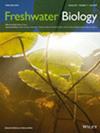紫外线照射诱导Cisco (Coregonus artedi)胚胎逃逸孵化
IF 2.7
2区 生物学
Q2 ECOLOGY
引用次数: 0
摘要
思科(Otoonapii);Coregonus artedi Lesueur, 1818)是一种分布广泛的低温淡水鱼,其胚胎通常在冰下和黑暗中孵化。我们使用Cisco作为模型生物来测试紫外线诱导的逃逸孵化行为的潜力。由于北温带湖泊的冰盖减少和水透明度增加,这些实验提供了对暴露于紫外线辐射(UV-B;280 - 320 nm)。通过一系列实验,将有眼的Cisco胚胎暴露于人工来源的UV-B中,在孵化后2天,在冷[6.6°C]和暖[8.6°C]条件下测量孵化率和适合度(心率和色素模式)。这些实验支持了逃逸孵化行为假说的延伸,即UV-B暴露导致Cisco胚胎更早(约30天)和更间断的孵化,与水温的升高无关。暴露在UV-B下会产生更多具有不规则色素模式的幼虫,并降低心率(约20%)——这两种情况都可能表明适应性降低。紫外线诱导逃逸孵化调整了我们描述鱼类胚胎对UV-B暴露增加和冰盖减少的潜在后果的恢复能力的基本框架。暴露在UV-B下的早期孵化可能会减少孵化后幼虫的存活率,从而增加这些鱼的招募瓶颈。本文章由计算机程序翻译,如有差异,请以英文原文为准。
Exposure to Ultraviolet Radiation Induces Escape Hatching of Cisco (Coregonus artedi) Embryos
- Cisco (Otoonapii in Ojibwe; Coregonus artedi Lesueur, 1818), is a widely distributed stenothermic freshwater fish whose embryos typically incubate under ice and in the dark. We used Cisco as a model organism for testing the potential of UV-induced escape hatching behaviour. Owing to reduced ice cover and increased water transparency in north temperate lakes, these experiments provide insights into the resilience of coregonine embryos if exposed to ultraviolet radiation (UV-B; 280–320 nm).
- Eyed Cisco embryos were exposed to artificially sourced UV-B through a series of experiments that measured the hatching rate and fitness (heart rate and pigmentation pattern) 2 days after hatching and under cold [6.6°C] and warm [8.6°C] conditions.
- These experiments supported an extension of the escape hatching behaviour hypothesis, whereby UV-B exposure induced earlier (ca 30 days) and more punctuated hatching of Cisco embryos, independent of an increase in water temperature. UV-B exposure produced more larvae with irregular pigmentation patterns and reduced heart rates (by about 20%) – both of which could be indicative of reduced fitness.
- UV-induced escape hatching adusts the fundamental framework in which we characterise fish embryo resilience to increased UV-B exposure and the potential consequences of reduced ice cover. Earlier hatching from UV-B exposure could increase the recruitment bottleneck of these fish by reducing survivorship of the post-hatched larvae.
求助全文
通过发布文献求助,成功后即可免费获取论文全文。
去求助
来源期刊

Freshwater Biology
生物-海洋与淡水生物学
CiteScore
5.90
自引率
3.70%
发文量
162
审稿时长
2 months
期刊介绍:
Freshwater Biology publishes papers on all aspects of the ecology of inland waters, including rivers and lakes, ground waters, flood plains and other freshwater wetlands. We include studies of micro-organisms, algae, macrophytes, invertebrates, fish and other vertebrates, as well as those concerning whole systems and related physical and chemical aspects of the environment, provided that they have clear biological relevance.
Studies may focus at any level in the ecological hierarchy from physiological ecology and animal behaviour, through population dynamics and evolutionary genetics, to community interactions, biogeography and ecosystem functioning. They may also be at any scale: from microhabitat to landscape, and continental to global. Preference is given to research, whether meta-analytical, experimental, theoretical or descriptive, highlighting causal (ecological) mechanisms from which clearly stated hypotheses are derived. Manuscripts with an experimental or conceptual flavour are particularly welcome, as are those or which integrate laboratory and field work, and studies from less well researched areas of the world. Priority is given to submissions that are likely to interest a wide range of readers.
We encourage submission of papers well grounded in ecological theory that deal with issues related to the conservation and management of inland waters. Papers interpreting fundamental research in a way that makes clear its applied, strategic or socio-economic relevance are also welcome.
Review articles (FRESHWATER BIOLOGY REVIEWS) and discussion papers (OPINION) are also invited: these enable authors to publish high-quality material outside the constraints of standard research papers.
 求助内容:
求助内容: 应助结果提醒方式:
应助结果提醒方式:


